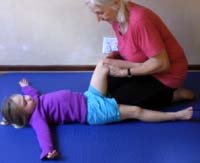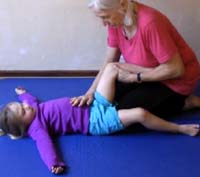Given normal, healthy joint surfaces, full range of movement depends on the extensibility and mobility of the soft tissue structures. This is particularly true of movements that require elongation of myo-fascial-neural (M-F-N) structures over more than one joint.
Short duration (minutes) passive stretching the M-F-N structures does not usually give an immediate increase in the range of movement.
However, active stretching techniques such as the PNF hold relax technique, have been shown to produce an immediate increase in range of movement. The principle of the hold-relax technique is to induce a maximal isometric contraction of the targeted muscles in the lengthened range. The assumption is that the maximal contraction is followed by maximal relaxation, which allows the muscle to lengthen more than before the contraction (Riley 2012)
SfA Active mobilization and active stretching techniques
Active mobilization and stretching use the same basic principle as PNF hold relax: select a position that lengthens the soft tissue structures that are restricted and then, maintaining the stretch on the elongated structures, encourage active movement that induces a contraction in the surrounding muscles.
Lengthening of the restricted soft tissues is sometime supplemented by a gentle sustained longitudinal force through the joint (adapted from Maitland mobilization).
The underlying mechanism promoting an increase in range of movement probably relates to changes in the visco-elastic behaviour of the areolar tissue that lies between the connective tissue layers of fascia in the myo-fascial-neural system. Bibliography
The basic technique
In active mobilization the limb segments are passively moved to a position where the target muscles and related fascial structures are lengthened (stretched).
- The limb position is then maintained by an external force (manual holding by the therapist) during several cycles of contraction – relaxation of the target and surrounding muscles.
- If the techniques is effective there will be an increase in the range of movement following the application of the active mobilization technique.
- Active mobilization is followed by activities that involve the tight muscles in their lengthened range of movement.
Active mobilization techniques are ideal for increasing flexibility in infants because they do not expect the infant to be still, but rather encourage the infant to be active, during the maneuver.


The following video clip illustrated the basic principles.
The infant has some tightness in the extensor muscles of the neck which is affecting his ability to lift his head when pulled to sitting.

The video shows me applying a gentle stretch to the neck while encouraging the infant to kick and reach for a toy which engages the neck muscles.
Active mobilization to increase straight leg raise (SLR)
Structures that limit SLR include:
The structures limiting straight leg raise include: lumbodorsal fascial, gluteal fascia, iliotibial band, fascia lata, hamstring muscles and their related fascial extensions, and the neurovascular bundle related to the sciatic nerve.

The therapist holds the limb in this position and applies a longitudinal force along the long axis of the femur which stretches the shorter structures around the hip joint.
The therapist maintains the limb in this position for the duration of the cycle of contraction-relaxation of the target muscles.


Video demonstration
More ideas for active mobilization and stretching
Available to TOMT subscribers Read more